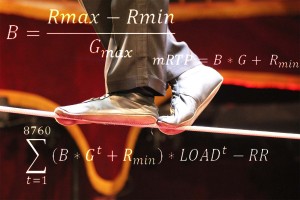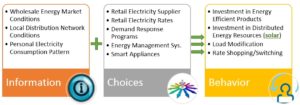
Most electricity consumers in Washington still pay a flat rate for their energy, which can be adjusted seasonally. Unlike a cell phone plan that offers an array of pricing plans and carriers, electricity has traditionally been priced at a one-size-fits-all economic model. But that is changing quickly as smart meters become more commonplace in the U.S. Smart meters allow the utilities and customers to know how much energy is being consumed every 15 minutes. By 2015, its estimated that half of the meters in the U.S. will be “smart,” allowing utilities more opportunities to engage customers in their own energy management.
For example, a smart meter or smart thermostat can alert a home owner that because of the current demand for electricity in their region, the price of electricity and therefore cost of running the air conditioner or washing machine has now gone up. The customer can decide if it the comfort of having the temperature in their home a few degrees cooler is worth cost. Or, a utility could set pricing depending on the time of day to make it more affordable for people to do their laundry at night or on the weekends, instead of during weekdays when the demand for electricity from the grid is at its peak.
Professor Daniel Kirschen and UW Graduate student Ahlmahz Negash are using data from utilities to understand customer purchasing behavior. The research looks at the future of electricity pricing and proposes an option to allow customers more choices while also allowing utilities to charge prices that reflect the actual cost of energy and its delivery to each end use customer.
The pricing models are based upon the following assumptions:
Consumers will respond to economic pricing signals when it comes to “purchasing” electricity. The most effective means of encouraging consumers to actively monitor and control their electricity use is to offer economic signals in real time as well as sufficient choices in order to limit their risk of high prices. That means homeowners want know what the rate is at any given point in time when choosing to use or conserve. They also want to a variety of different choices, including rate packages that are more customized to their use, opportunities to purchase renewable power, and even a choice of utility and electricity suppliers.
Local conditions matter. Today, most time of use pricing models are based on the wholesale energy markets. However, if a particular sub market is experiencing unusually high consumption and placing stress on their local grid components, Nagesh’s model accounts for a higher price to reflect that local stress (even if wholesale prices are low.) With this information, consumers can choose to pay the higher cost for comfort, or conserve and help reduce stress on the grid.
Risk versus reward powers choice. If customers feel empowered by their choices, i.e. the ability to individually balance risk versus reward, they are more willing to be active energy buyers. Consumers are willing to risk a higher cost for electricity during peak hours if they perceive a sufficient reward for conservation. Historically, real time pricing models have not had a cap on the highest rate that could be charged. If for example, a peak jumped as high as $9 per kilowatt hour, it would be a major deterrent for customers’ participation in time of use programs. Consumers are most comfortable when offered a range of rates with a cap, from two cents to 20 cents per kilowatt hour for example, so they could manage their price risk.
Over the long term this types of pricing structures could benefit both consumers and utilities as they become closer partners in energy pricing and efficiency. “It is only a matter of time before all utilities began to redesign their rates to better reflect the dynamics of power generation, transmission and distribution costs,” according to Nagesh. “The future cannot have high-tech devices and low-tech prices.”
The introduction of new pricing strategies could benefit both supplier and consumer. Utilities will be able to redesign their rates to better reflect the dynamics of power generation, transmission and distribution costs. Consumers will be offered more choices and the ability to more directly manage their utility bills. They also have more information to “shop” for rates based on their need and budget.
For more information on this study, see the paper Compensation of Demand Response in Competitive Wholesale Markets vs. Retail Incentives.





